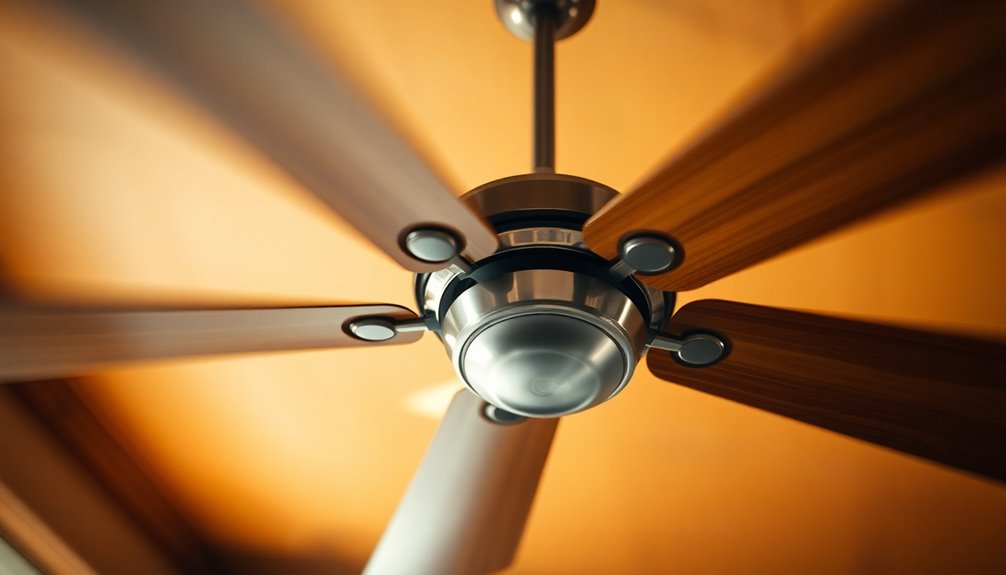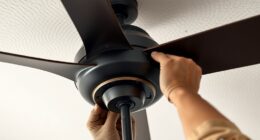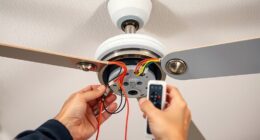Your ceiling fan might be making a grinding noise due to several reasons. Check for loose or worn-out parts; tightening screws may fix it. Unbalanced or warped blades can also cause noise, so inspect their alignment. Additionally, dirty or damaged bearings may create friction. Verify the fan is properly installed, as an unstable mount can worsen sounds. Finally, keep an eye on electrical connections, as issues there can lead to buzzing. Addressing these potential problems can reduce noise and improve performance. Discover more tips to keep your fan operating smoothly and quietly.
Key Takeaways
- Grinding noise may be caused by loose or worn-out parts; inspect and tighten visible screws and components regularly.
- Unbalanced or warped blades can lead to noise; check blade alignment and use a balancing kit if necessary.
- Dirty or damaged bearings create friction and noise; clean and lubricate bearings to ensure smooth operation.
- Improper installation can cause instability and noise; verify secure mounting and correct blade height for optimal performance.
- Electrical issues such as loose connections may lead to buzzing sounds; inspect wiring and motor components for visible damage.
Loose or Worn-Out Parts
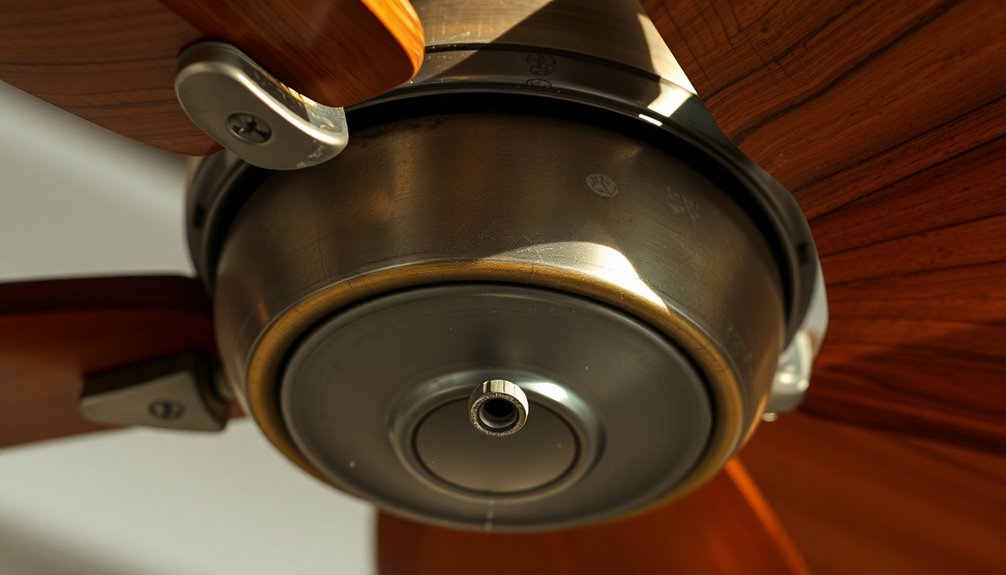
If your ceiling fan is making a grinding noise, it could be due to loose or worn-out parts. Over time, vibrations from the fan's operation can cause screws and bolts to loosen, leading to a wobbly fan that generates unwanted noise.
Start by inspecting all visible screws connecting the fan to the ceiling and those holding the blades. Tightening these fasteners can often resolve the issue, but be careful not to over-tighten, as this might strip the threads.
Worn-out parts like blade holders and downrods might also be the culprits. If you notice rattling or clicking sounds, check the screws connecting the blade irons to the motor; tightening them may help.
However, if the grinding persists, it's likely time to replace any worn-out components. Regular inspections can help you spot these issues before they escalate. Additionally, ensure that you conduct routine maintenance checks to prevent future noise problems.
Lastly, verify that all electrical connections are secure. Loose connections can contribute to additional noise problems.
Unbalanced or Warped Blades

Experiencing a grinding noise from your ceiling fan may indicate unbalanced or warped blades. This issue often arises from misalignment, where blades spin at different heights, creating uneven airflow and causing a wobble. To check for misalignment, measure blade heights with a yardstick or use a reference point like a doorway. If you find misaligned blades, you can adjust or bend them, but be cautious—repeated bending can weaken the blade holder. Regular cleaning is essential to prevent dust accumulation, which can lead to further imbalance. Additionally, maintaining your fan with energy-efficient motors can help reduce noise and improve overall performance. High CFM ratings are also beneficial for enhancing airflow and reducing strain on the fan.
Warped or bent blades can also lead to grinding noises. They may warp due to accidental bumps, moisture, or loose screws. Inspect each blade on a flat surface for any curvature or twisting. If you spot any warping, replacing the damaged blades is vital, as they can distort airflow and exacerbate wobbling.
To balance the blades, consider using a balancing kit from a home center. Attach the clip to the blade's trailing edge and adjust its position until the wobbling stops.
Dirty or Damaged Bearings
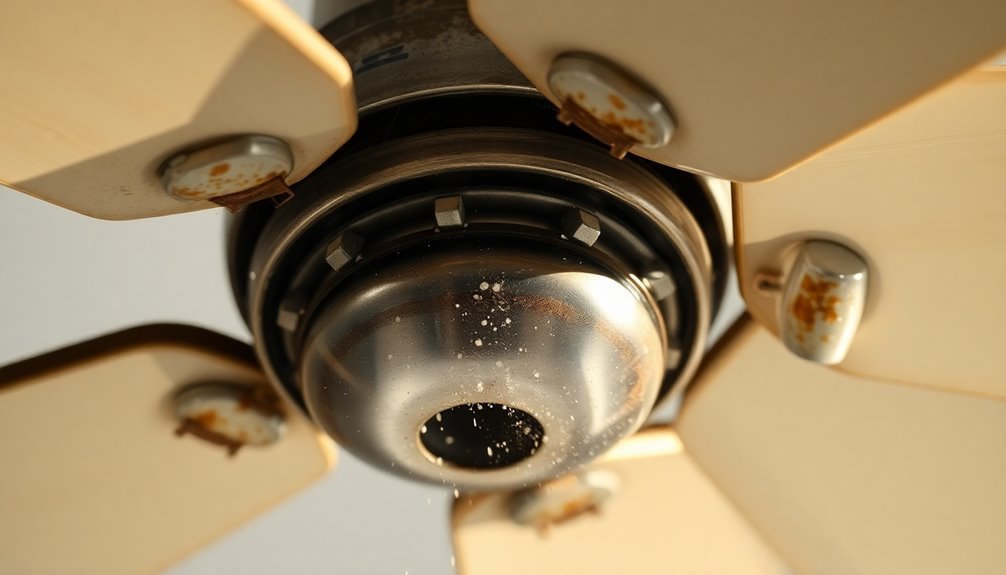
A grinding noise from your ceiling fan often points to dirty or damaged bearings. Over time, dust and debris can accumulate on the bearings, increasing friction and creating that annoying grinding sound. To prevent this buildup, regular cleaning should be part of your annual maintenance routine. If you neglect this task, you might face persistent noise issues.
Another cause of the grinding noise is a lack of lubrication. Bearings need proper lubrication to reduce friction and wear. Without it, you can experience increased noise and potential damage. Be cautious about the type of lubricant you use; detergent-based oils can worsen the problem. Stick to non-detergent motor oil with a weight of 10, 15, or 20. Regular fan maintenance is recommended every 1-2 years to extend the life of the ceiling fan and improve performance.
Normal wear and tear can also contribute to noise. As bearings age, they become more susceptible to damage, which may not be fixable with just oiling. Regular inspections can help you catch wear before it leads to significant noise.
If the bearings are irreparably damaged, oiling might only provide temporary relief, and replacing the fan could be a more cost-effective solution in the long run.
Improper Installation or Mounting

While dirty or damaged bearings can certainly lead to grinding noises in your ceiling fan, improper installation or mounting can also be a significant culprit.
If your fan isn't securely mounted to the ceiling or the mounting bracket, it might wobble or vibrate, creating those annoying grinding sounds. Loose screws or bolts can cause instability that contributes to the noise, so verify everything is tightened properly.
Another issue could be incorrect blade height. If the blades are installed at inconsistent heights, the fan can become unbalanced, leading to vibrations and grinding. Misaligned blades may scrape against the motor housing, generating more noise. Incorrect bracket size can also exacerbate this issue, as the fan may not be properly supported.
Adjusting the blade brackets can help achieve consistent height and reduce stress on the motor.
Using the wrong mounting system also matters. Not every ceiling fan model is compatible with universal mounting brackets.
Confirm your mounting system matches your fan and ceiling type—like sloped or dropped ceilings. If you're unsure about your installation, consider hiring a professional electrician to prevent further issues.
Inspecting for misalignments or loose connections is essential to eliminate those grinding noises.
Electrical Issues
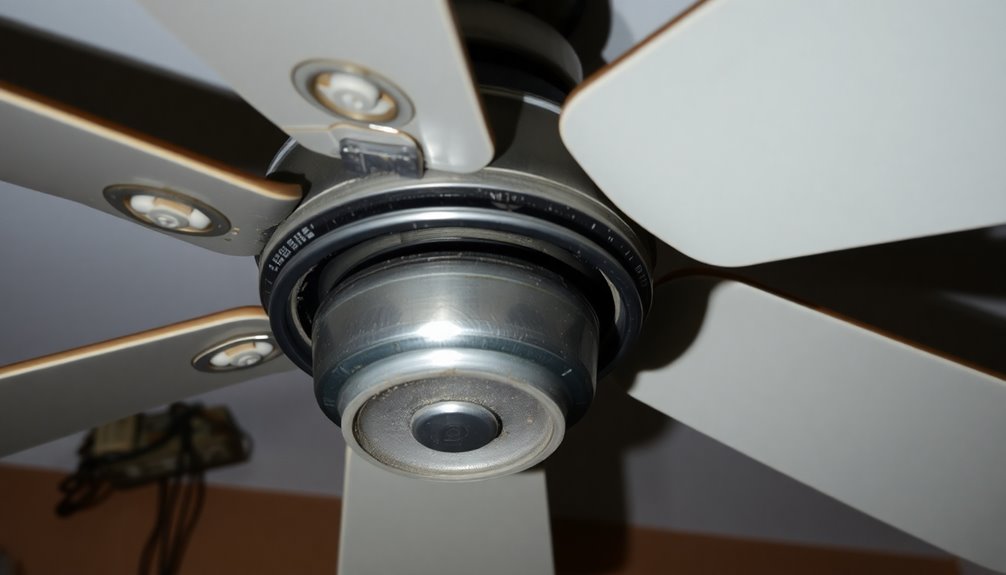
Electrical issues can often be the source of those frustrating grinding noises in your ceiling fan. Loose or incorrect electrical connections can create buzzing or grinding sounds, making it vital to guarantee everything's secured correctly.
If you notice dimming or flickering lights, this might indicate loose or damaged wiring within the fan, which could also affect its speed and operation. Dimming or flickering lights can signal serious underlying electrical problems that require immediate attention.
Inspecting the motor and bearings is another important step. Dirty or damaged bearings can generate friction, leading to those pesky grinding noises. Oiling these bearings is only a temporary fix and might worsen the issue over time.
Look for any visible damage in the motor housing and bearings as well.
Capacitor problems can also contribute to electrical noise. If the fan operates inconsistently or at a slower speed, it might be due to a faulty capacitor. Replacing this component can often resolve both speed issues and related noises.
Lastly, guarantee that all wires are neatly tucked away, especially in flush mount fans. Wire interference can result in clicking or buzzing, so managing wiring properly is key for smooth operation.
Regular Maintenance Practices
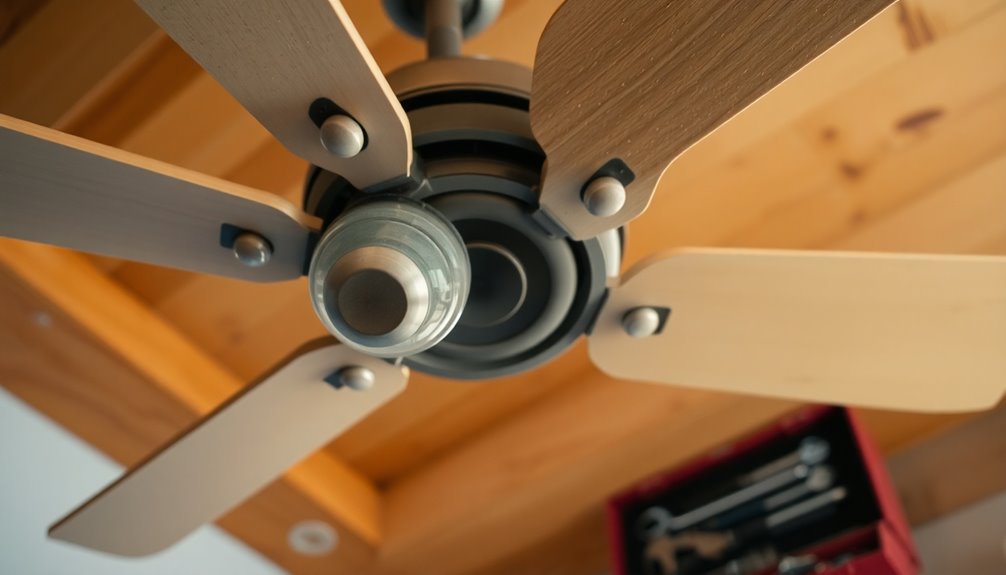
Regular maintenance practices are essential for keeping your ceiling fan running smoothly and quietly. By following a few simple steps, you can prevent grinding noises and guarantee your fan operates efficiently.
- Clean Regularly: Use a dry fan brush to remove dust, then a damp cloth with soapy water for sticky stains. Don't forget to vacuum the motor vents to keep dust at bay.
- Lubricate as Needed: Check your user manual for lubrication requirements. If necessary, apply non-detergent motor oil to prevent overheating and ensure energy efficiency in home appliances.
- Tighten and Secure: Inspect and tighten all screws around the blades and motor housing. Replace any missing screws to avoid noise and wobbling.
- Schedule Professional Servicing: Every 12–18 months, have a technician check for motor issues and wiring problems, especially for fans in high-use environments.
Signs of Fan Imbalance
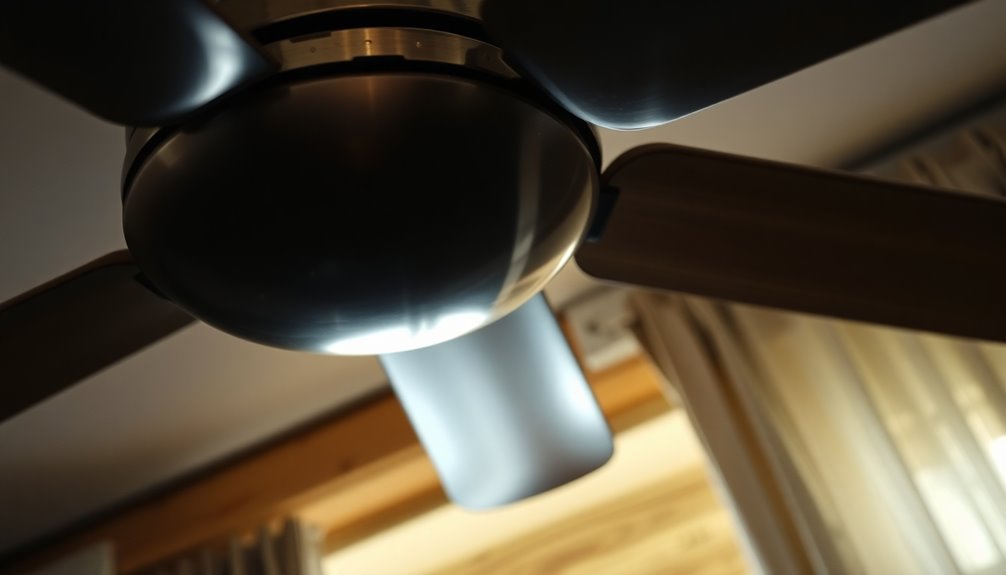
When your ceiling fan starts to wobble or make unusual noises, it often indicates an imbalance that needs your attention. One of the first signs of imbalance is loose or misaligned components. Check for loose blade screws or brackets, as even a small misalignment can cause significant wobbling.
Additionally, inspect the downrod support screws and the hanger ball to ascertain they're securely in place.
Blade conditions are essential as well. Warped or damaged blades disrupt balance, so look for any signs of wear. Dust and dirt accumulation can add uneven weight too, leading to discomfort in operation. If your blades aren't identical in weight, length, or width, that's another potential culprit. Misaligned blade holders can also contribute to the imbalance, causing the fan to operate inefficiently.
Improper installation can also lead to instability. Verify that the fan is mounted correctly, using an appropriate electrical box. Tighten all lag screws and confirm that blade arms are securely attached to the motor housing.
Finally, pay attention to visual and auditory indicators. If you notice grinding, humming, or buzzing sounds, or if the blades aren't rotating evenly, it's time to investigate further.
Addressing these signs early can help keep your fan operating smoothly.
Importance of Lubrication
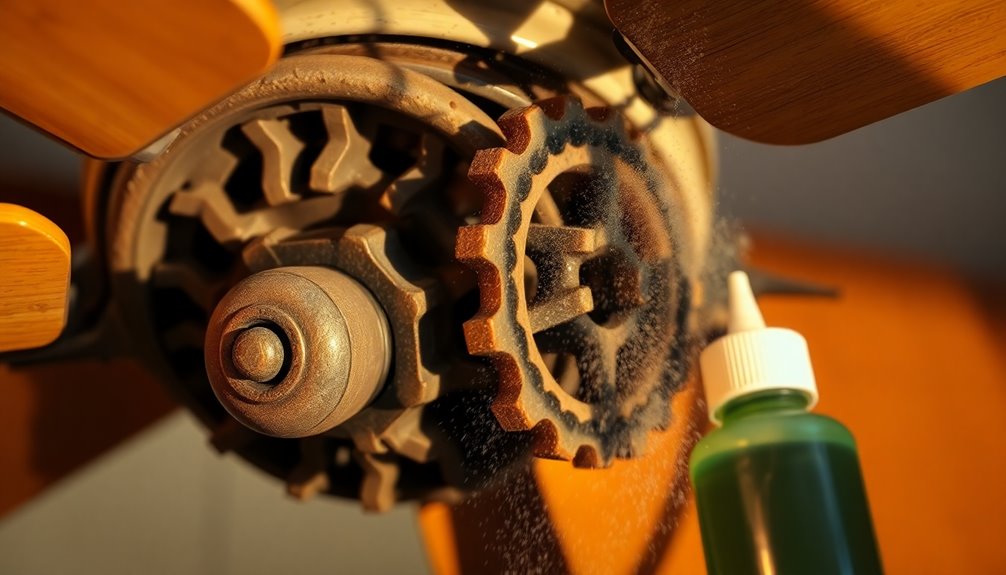
Lubrication is vital for keeping your ceiling fan running efficiently and quietly. Without proper lubrication, your fan can start to make grinding noises due to increased friction between its moving parts. Regular maintenance helps avoid excessive wear and guarantees that your fan operates smoothly.
Here are some key reasons why lubrication is essential:
- Reduces friction between moving parts
- Prevents excessive wear on components like bearings and motor
- Guarantees the fan runs quietly and smoothly
- Extends the lifespan of the ceiling fan
- Regular lubrication enhances overall efficiency of air circulation.
Using the right type of lubricant is also important. Opt for high-quality, non-detergent oil specifically designed for electric motors, as it helps distribute air effectively during both summer and winter.
Avoid using 3-in-1 oil or WD-40, which can gum up the bearings.
Apply a few drops of oil through the oil hole, if available, and rotate the fan blades manually to spread the oil evenly.
Make it a habit to lubricate your ceiling fan at least once a year, as this simple maintenance can greatly reduce the risk of a noisy fan and prolong its life.
How to Tighten Components

Tightening the components of your ceiling fan is essential for minimizing noise and guaranteeing smooth operation. Start by checking the blade screws, typically located near the fan motor housing. Use a screwdriver to tighten each screw securely, as loose screws can cause blade ticks and grinding sounds. Regularly inspect these screws, since vibrations from use can lead to looseness over time.
Next, secure the fan canopy. Wiggle it gently to see if it's loose, and then tighten any fasteners you find using the correct tool. If your canopy is threaded, carefully twist and pull it down to tighten properly. A well-aligned and securely mounted canopy can eliminate annoying clicking or scraping noises. Additionally, a loose mounting bracket can lead to vibrations, further contributing to unwanted sounds.
Don't forget to verify blade balance. Turn off the fan and gently push each blade upward to check if they're level. If they're uneven, use a blade balancing kit to attach clips and adhesive weights as needed.
Finally, inspect electrical and motor components. Confirm all connections are secure, and check for any loose or misaligned parts that could be causing noise. Regular tightening and maintenance will keep your ceiling fan running quietly and efficiently.
When to Call a Professional
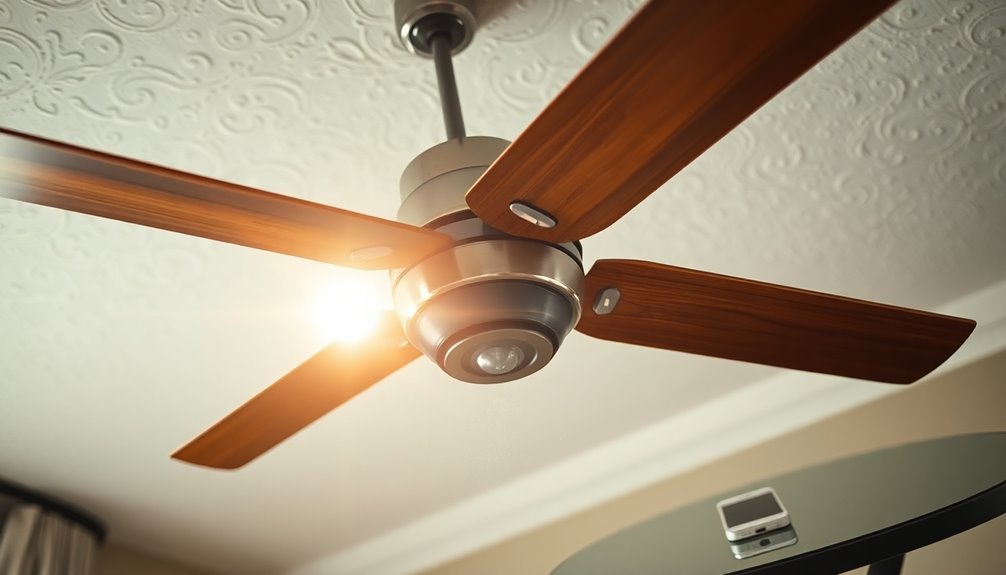
If you've tried tightening components and the grinding noise persists, it might be time to call a professional.
Electrical concerns, like flickering lights or overheating parts, can pose serious safety risks that shouldn't be ignored. Getting expert help guarantees you address the issue correctly and safely.
Additionally, worn-out bearings may be the cause of the grinding noise, which often requires professional intervention to replace.
Persistent Noise Issues
When you hear a persistent grinding noise from your ceiling fan, it's time to contemplate calling a professional. While you can try basic fixes, ongoing issues often indicate more significant problems such as motor and bearing wear, imbalanced blades, or even improper installation. It is essential to recognize that worn-out bearings can create friction, leading to those grinding sounds.
If you notice any of the following signs, don't hesitate to reach out for expert help:
- Worn-out motor bearings: Grinding sounds can indicate dirty or unlubricated bearings that need replacing.
- Unbalanced or damaged blades: Misaligned or warped blades cause vibrations that lead to persistent noise.
- Poor installation: If the fan isn't mounted securely, it may wobble and create grinding sounds.
- Complex mechanical issues: Some problems require professional tools and expertise to diagnose and repair effectively.
Ignoring these persistent noises can lead to more severe damage or even safety risks.
A professional technician can assess the situation, perform necessary repairs, and guarantee your ceiling fan operates smoothly and quietly.
Regular maintenance can prevent these issues, but when they arise, don't wait too long to call for help.
Electrical Concerns Present
Electrical issues can be a significant contributor to grinding noises in your ceiling fan, and addressing them promptly is vital. If you notice persistent grinding sounds after checking the screws and electrical connections, it may indicate deeper issues.
| Issue | Symptoms | Action |
|---|---|---|
| Loose Electrical Connections | Humming, buzzing, potential grinding | Secure connections |
| Improper Motor Alignment | Grinding from blade contact | Realign or replace the motor |
| Worn Motor Bearings | Grinding noise, overheating | Replace the motor |
| Insecure Mounting | Wobbling, rattling | Tighten or reinstall the fan |
| Overworked Motor | Grinding, reduced performance | Consult a professional |
If the fan's speed is stuck or if it requires a new capacitor, you should call a trained electrician. Attempting DIY repairs can lead to further damage or safety hazards. When in doubt about electrical concerns, it's always better to err on the side of caution and seek professional help to guarantee your ceiling fan operates safely and quietly. Additionally, loose blade screws can also cause grinding noises, so it's important to check them as well.
Frequently Asked Questions
Can a Grinding Noise Affect the Efficiency of My Ceiling Fan?
Yes, a grinding noise definitely affects your ceiling fan's efficiency.
When you hear that sound, it often means there's friction in the system, which reduces airflow and forces the motor to work harder. This can lead to increased energy consumption and even premature wear on components.
If you ignore it, you risk complete failure, resulting in costly repairs or replacements.
Taking action sooner can help maintain your fan's performance and lifespan.
How Often Should I Clean My Ceiling Fan to Prevent Noise?
Did you know that a dirty ceiling fan can circulate over 50% more dust into your home?
To prevent this, you should clean your fan every three months for peak performance. If you live in a dusty area or have pets, consider cleaning it every two months.
Weekly dusting and monthly deep cleaning with soap and water will help maintain its cleanliness, ensuring efficient operation and reducing the buildup of noise from dirt.
What Are the Signs My Ceiling Fan Needs Replacing?
If your ceiling fan's showing signs it needs replacing, pay attention to unusual noises, especially grinding or squeaking.
You might notice inconsistent speeds or a motor that struggles to start. Check for wobbly blades, vibrations, or visible wear on parts.
If it's not circulating air efficiently and the energy bill's climbing, it's likely time to contemplate a new fan.
Don't ignore these signs; they could save you money and improve comfort.
Can I Use Any Lubricant on My Ceiling Fan Bearings?
Did you know that using the wrong lubricant can shorten your ceiling fan's lifespan by up to 50%?
You can't just use any lubricant on your ceiling fan bearings. Stick to synthetic oils like Liquid Bearings or 3-in-one oil, as they're designed for this purpose.
Avoid WD-40 and mineral oils, since they can damage the bearings or leave residue.
Always check compatibility to keep your fan running smoothly and efficiently.
Is It Safe to Run a Noisy Ceiling Fan Until Fixed?
It's not safe to run a noisy ceiling fan until you fix it.
The noise often signals loose parts or electrical issues that could lead to a fire hazard. If you notice a burning smell or flickering lights, it's essential to turn off the fan immediately.
Ignoring the problem can cause further damage to the motor or even lead to accidents.
Take the time to inspect and repair the fan for your safety.
Conclusion
To sum up, if your ceiling fan's making a grinding noise, it's like a persistent itch you can't ignore. By addressing loose parts, unbalanced blades, or dirty bearings, you can restore peace to your home. Keeping your fan well-maintained with regular lubrication can prevent future issues. If the noise persists despite your efforts, don't hesitate to call a professional. Remember, a quiet fan means a more serene space for you and your family.




